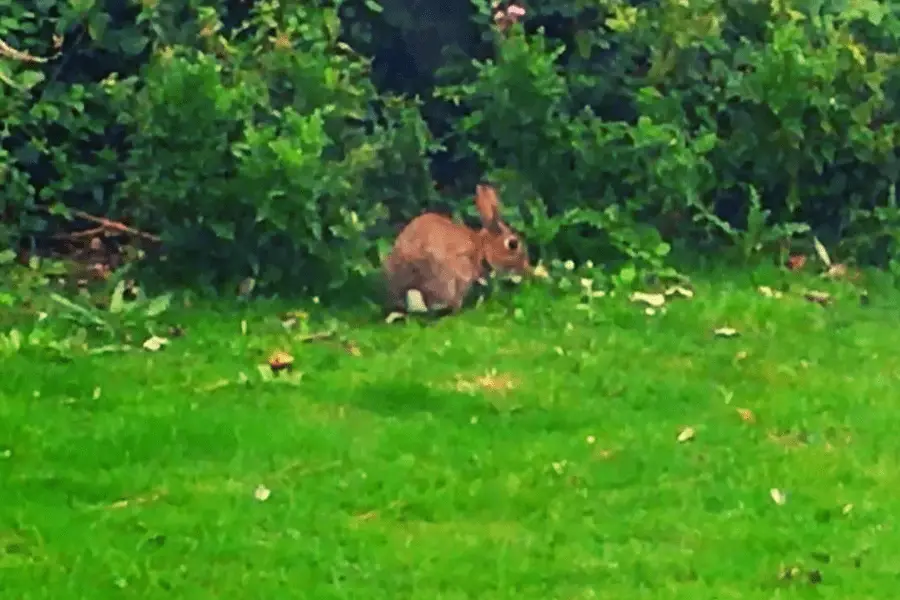Wild rabbits naturally have some advantages over domesticated pet rabbits which help them to survive in harsh conditions but when it comes to food would wild rabbits do well on what our domestic pets consume? We recently went into great detail to describe what we are able to feed our pet rabbits, but how about their wild relatives? what do wild rabbits eat?
Wild rabbits eat grasses, weeds, and non-poisonous plants including tree saplings, flowers, and berries. In winter when vegetation is more difficult to find they will also eat bark, twigs, and evergreens.
That’s the short answer but perhaps you’ve found a wild rabbit and your wondering what you should be feeding it? the unfortunate truth is that wild rabbit, particularly a baby will have a very slim chance of survival without the help of an experienced wildlife rehabber. That said, its worth knowing what makes up a wild rabbits natural diet and bearing it in mind when feeding our domesticated pet breeds.
What can I feed a wild rabbit?
The good news is that you can feed a wild rabbit anything you can feed a domestic rabbit. Anatomically, they are the same.
Rabbits are herbivores which means that they only eat food that is grown or derived from plants. Although they will likely never have the opportunity to eat the wide selection of vegetables, herbs and fruits our domesticated rabbits are afforded, their anatomy and dietary requirement is no different to that of our domestic pets.
The natural diet of a wild rabbit is much more likely to foster a healthy digestive system than the diets of our domestic pet rabbits (obesity is never an issue with a wild rabbit!).

Depending on the habitat and location, wild rabbits will eat any safe vegetation they can find to survive. Their digestives system is has adapted perfectly for breaking down fibrous plant material including hays and grass and shrubbery and this coarse material also helps to keep their teeth which are rootless and grow continuously at a healthy length.
The often low nutritional value of these grasses and hays also means that rabbits not only need to eat large quantities but they also re-ingest one specific form of their poop (caecotrophs) in order to get as much nutritional value as they can out of the food.
As for a wild rabbit in captivity, it will happily eat exactly what domesticated rabbits are given, hay, veggies, pellets and fresh water however as with any wild animal, the intention should always be to release it at the earliest opportunity and allowing it to get too accustomed to domestic life is a bad idea.

If your feeding a wild rabbit, try to give only foods that it would likely to find in its natural habitat. A good idea is to going outside to where you found it and doing some foraging yourself. Unusual (non native) veggies and fruits (e.g. mangos or a banana) are more likely to upset the delicate balance of its digestive system.
List of foods to feed a wild rabbit
Here are some hays, simple veggies/fruits and flowers you can feed a wild rabbit.
Note that fresh foods should be rinsed thoroughly before offering them to the wild rabbit and replaced if not eaten in a few hours.
For a more extensive list of rabbit foods visit our post here (link to post ‘What Can Rabbits Eat – Complete Guide and Quick Reference Table’)
| Hays | Orchard hay; Oat Hay Clover Hay Meadow Hay Timothy hay Alfalfa Hay (see note below) |
| Vegetables | collard greens Kale Chard Turnip Greens Cabbage Carrot Tops Radish Tops Parsley Watercress Dandelion Leaves |
| Fruits (in very small quantities) | Apple Blueberries Raspberries Strawberries and tops |
| Flowers | Clover Daisys Dandelions Yarrow Sunflowers |
Alfalfa Hay
Alfalfa (sometimes referred to as ‘lucerne’) is a legume hay in the pea family. In terms of nutrients, it’s higher in protein and minerals than grass hays and is used mainly as a feed for horses, cattle, chickens, sheep, turkeys, dairy cows and other farm animals
As a high nutrient/high energy hay brand it does have some benefits for kits and young rabbits and its palatability also makes it a good source of food for underweight rabbits or those recovering from an illness.
While you may use alfalfa as part of a mix alongside grass hays, feeding it as the main source of hay for an adult rabbit is not recommended due to a high calcium content that may contribute to the formation of bladder sludge or stones (solid build-ups of crystals made from minerals and proteins).
Can wild rabbits eat pellets?
Hay should form 80% of the diet however, you can supplement the diet with pellets also. If the orphaned wild rabbit is a baby, you can start introducing high protein alfalfa pellets as well as veggies as soon as their eyes are open.
Can I feed wild rabbit carrots?
Wild rabbits can eat carrots along with other vegetables but they rarely have the opportunity. Remember, carrots are a high sugar food that should only be given in small amounts, although a wild rabbit will have a better tolerance for foods that may make our domestic rabbits sick, similarly they are not used to the high sugar veggies our domestic pets are. Always observe the small amounts rule to ensure there are no gastrointestinal issues.
Baby wild rabbits
Those of us who are privileged to have a one on one encounter with a wild rabbit may have either found one that has had to flee from a disturbed nest or much more likely is that its a rabbit that has already begun leaving the nest to explore.
In the wild rabbit mothers will hide their nests in plain sight (for example in the middle of a lawn or field) and will sit away from their nest or go off to forage for long periods, only returning once or twice per day to nurse the kits. This means that the very first thing that a wild rabbit eats is a very nutrient dense milk produced by its mother.
Because of the infrequent nature of the feeds, the mother’s milk is extremely protein, fat, and nutrient-dense. This in turn means that the young kits mature quickly, being ready to leave the nest at around 3-4 weeks of age, in which case it should be left alone rather than carrying out an unnecessary rescue.
In the unlikely event that a rabbit is in need of assistance (visible signs of neglect, dehydration, or injury) it may be that you need to step in and help however, if it shows any resistance to being captured or picked up, you should leave it alone.
At around 9 weeks of age a wild rabbit will slowly transition from the mothers milk to a diet which more closely resembles that of our domestic pet rabbits. (obviously fresh store bought veggies won’t be available in the wild so foraging for those essential nutirients is necessary).
For the few rare occasions when a genuine wild baby rabbit is found in need of assistance, an experienced rehabber should be consulted immediately to give the rabbit the best chance of survival.
Attempting to match the nutrient rich mothers milk using KMR (Kitten Milk Replacement) is difficult. The amount of food will vary significantly depending on age and giving too much can lead to bloating and death through overfeeding.
Here is an important quote from the House Rabbit Society:
Fewer than 10% of orphaned rabbits survive a week, and the care that people attempt to provide can be illegal, unnecessary, and potentially harmful. The best thing you can do is put the bunny right back where you found him, in the general area, as the mom will only come back at night to call and find him.
House Rabbit Society
Wrap up
While we have briefly described what a wild rabbit eats in the wild along with what you could potentially feed one if it was in captivity. The reality is that wild rabbits are exactly that, wild animals. Feeding of wild rabbits should be done ideally by wildlife rehab unless one is not available.
Rabbits kept captive for longer than necessary will most often die from stress either from excessive handling or not being with their own kind.

For this reason it’s very important to determine if a wild rabbit is a genuine orphan before intervening with any ‘help’ as in the majority of cases trying to help a seemingly abandoned rabbit will be doing it more harm than good.
If you have an orphaned rabbit and you have managed to successfully rehabilitate it back to the point that it is eating hay and greens, it should be returned to the wild during the hours of dawn or dusk to give it the best chance of survival.
Further Reading
Seven of the Most Extreme Milks in the Animal Kingdom Smithsonianmag.com
What to do about wild rabbits Humanesociety.org
Orphaned Baby Bunnies: Wild and Domestic Rabbit.org
